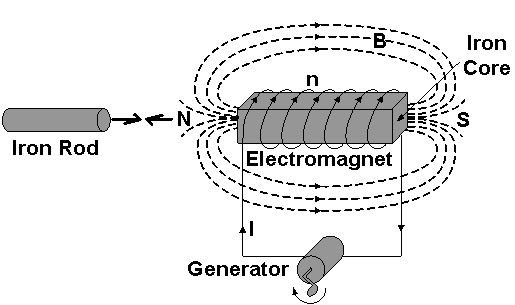Electromagnet
An Electromagnet is generally composed of a Coil around an Iron Core. These elements alone will not produce a Magnetic Field unless there is a Current flowing through the Coil. By connecting a Generator to the terminals of the Coil, the Electromagnet is energized and a Magnetic Field is created.
An energized Electromagnet acts like a normal Magnet. By placing a magnetic material, e.g. an Iron, next to it, a Magnetic Force is exerted on the Iron and they attract each other, Figure 1.
 Figure 1: An Iron Rod placed near the Electromagnet
Figure 1: An Iron Rod placed near the Electromagnet
Unlike permanent Magnets, it is possible to control the strength of the Magnetic Field in an Electromagnet. The magnetic field is characterized by Magnetic Flux Density (B), which is related to the Permeability of the Medium (μ), the Number of Turns of the Coil (n) and the Current flowing through the Coil (I), Figure 1. For a given Electromagnet, μ and n are constant, we can change I to control its strength of Magnetic Field.
As a daily-life example, a Circuit Breaker contains an Electromagnet. When the Current flowing through the Electromagnet exceeds the allowed limit, its Magnetic Force becomes large enough to Open the Switch.
Links
About CMM
Contact US
Others
Other Websites
Number of Visitors:
Last Modified Date: 10/3/2025